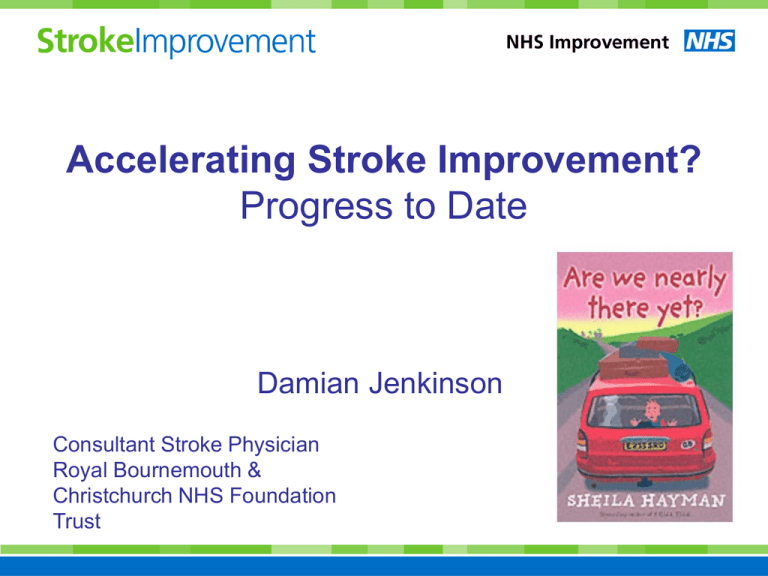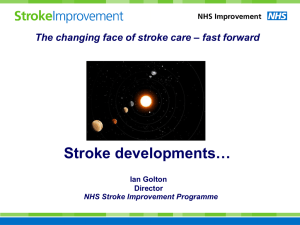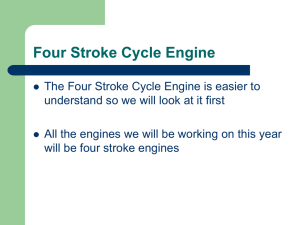Accelerating Stroke Improvement?
advertisement

Accelerating Stroke Improvement? Progress to Date Damian Jenkinson Consultant Stroke Physician Royal Bournemouth & Christchurch NHS Foundation Trust National Clinical Lead NHS Stroke Improvement Programme National advice and guidance Vital Signs Best Practice Tariff 2007 2010 Accelerating Stroke Improvement Stroke Quality Standard More emphasis Indicators along on prevention and the pathway on long term care Eleven process standards Domains Key measures (aim) Joining Up Prevention Proportion of patients with AF presenting with stroke anticoagulated on discharge (60% by April 2011) Proportion of people with high-risk TIA fully investigated and treated within 24 hours (60% by April 2011. Vital Sign) Implementing Best Practice in Acute Care Proportion of patients admitted directly to an acute stroke unit within 4 hours of hospital arrival (90% by April 2011) Proportion of patients spending 90% of their inpatient stay on a specialist stroke unit (80% by April 2011. Vital Sign) i) Proportion of stroke patients scanned within one hour of hospital arrival (50% by April 2011) ii) Proportion of stroke patients scanned within 24 hours of hospital arrival (100% by April 2011) Improving Post Hospital and Long Term Care i) Presence of a stroke skilled Early Supported Discharge team ii) Proportion of patients supported by a stroke skilled Early Supported Discharge team (40% by April 2011) Proportion of patients and carers with joint care plans on discharge from hospital to final place of residence (85% by April 2011) Proportion of stroke patients that are reviewed at six months after leaving hospital (95% by April 2011) Proportion of patients who have received psychological support for mood, behaviour or cognitive disturbance by six months after stroke. (40 % by April 2011) Stroke and TIA Vital Signs Trajectory to Target 80% Stroke: Proportion of patients spending more than 90% inpatient stay on a stroke unit 70% 60% Stroke desired position 90% stay on stroke unit STROKE TIA 50% TIA: Proportion of high-risk TIA patients completely treated within 24h of referral 40% TIA desired position High risk TIA treated <24h 30% Q1 Q2 Q3 Q4 Q1 Q2 Q3 Q4 Q1 Q2 Q3 STROKE 39% 40% 45% 47% 52% 58% 58% 61% 68% 73% 75% TIA 36% 40% 44% 47% 49% 46% 51% 56% 56% 58% 64% NB A definition change in Q1 08/09 means that direct comparisons with previous quarters may not necessarily be valid DH analysis of vital sign data Q4 ASI 1: Preventable Stroke ASI 1: Preventable Strokes 100% 90% Network Data Aspiration 80% 70% 60% Proportion of patients with AF presenting with stroke anticoagulated on discharge (60% by April 2011) 50% 40% 30% 20% Beds&Hearts Essex 0% Anglia 10% Stroke Network (Sorted by relative performance) • • • 13 networks reporting some data on anti-coagulation on discharge Most networks performing above 60% Using this to quantify strokes prevented / lives saved ASI 2: Direct admission 4 hours ASI 2: Direct Admission to Stroke Ward 100% 90% Network Data Aspiration 80% 70% 60% 50% 40% 30% 20% Essex Beds&Hearts 0% Anglia 10% Stroke Network (Sorted by relative performance) • • • 18 networks reporting data Average 48% 4862 strokes, 2358 admitted directly in under 4 hours Proportion of patients admitted directly to an acute stroke unit within 4 hours of hospital arrival (90% by April 2011) Performance data shows that London is performing better than all other SHAs in England 16% Thrombolysis rates have increased since implementation began to a rate higher than that reported for any large city elsewhere in the world 12% 12% 10% 10% 8% 6% 4% 3.5% 2% 0% Feb – Jul 2009 90 90 85 85 80 80 75 75 70 London 65 England 60 Target 55 AIM Feb – Jul 2010 % of TIA patients’ treatment initiated within 24 hours % achievement % achievement % of patients spending 90% of their time on a dedicated stroke unit 14% 70 London 65 England 60 Target 55 50 50 45 45 40 40 Q1 Q2 Q3 2009/10 Q4 Q1 2010/11 Q1 Q2 Q3 2009/10 Q4 Q1 2010/11 7 Supporting Life After Stroke Overall results Legend of stroke review Performing least w ell (36) Performing fair (35) Performing better (40) Performing best (40) What did the review find? Early supported discharge available across only 37% of areas In 48% of areas average waits for community based speech and language therapy exceed two weeks Only 37% of areas provide rehabilitation services to people based in their community, focusing on helping them return to work. In around a third of areas not all carers can access peer support, such as carer support groups or befriending schemes. Most people are given a pack of information when they leave hospital but only 40% of these packs contained good information on local services. While 68% of areas provided a named contact to help people plan and organise their care after transfer home, in only half of areas did these contacts look across health, social and community services ASI 6: Timely Access to Psychological Support ASI 6: Timely access psychological support 100% 90% Network Data Aspiration 80% 70% 60% 50% 40% 30% 20% Beds&Hearts Essex 0% Anglia 10% Proportion of patients who have received psychological support for mood, behaviour or cognitive disturbance by six months after stroke. (40 % by April 2011) Stroke Network (Sorted by relative performance) – Aspiration 40% - evidence of depression, anxiety and poor cognition rates from South London Stroke Register data – Psychological therapy examples on SIP website ASI 7: Joint Health and Social Care Plans ASI 7: Joint Health & Social Care Mgmt 100% 90% Network Data Aspiration 80% 70% 60% 50% 40% Proportion of patients and carers with joint care plans on discharge from hospital to final place of residence (85% by April 2011) 30% 20% Beds&Hearts Essex 0% Anglia 10% Stroke Network (Sorted by relative performance) – CQC Data “Is there an agreed process for integrated reviews of health and social care needs for those living at home?” – Joint Care Planning Resource on SIP website; consensus statement and case examples ASI 8: Assessment and Review ASI 8: Assessment and Review 100% 60% Proportion of stroke patients that are reviewed at six months after leaving hospital (95% by 50% April 2011) 90% Network Data Aspiration 80% 70% 40% 30% 20% Beds&Hearts Essex 0% Anglia 10% Stroke Network (Sorted by relative performance) – Proportion of patients reviewed 6 months after leaving hospital – Aspiration 95% of patients to be reviewed Policies for reviews 100% In s o m e a re a s P olic y 90% C lear w ho leads 80% 70% 60% No 50% In m o s t a re a s 40% 30% 20% In a ll a re a s 10% 0% at/ar ound 6 at/ar ound 6 w eeks months at 12 months annualy af ter that Current models of stroke reviews use a standardised tool, which cover, at a minimum, five key areas Topic 1: Medical and secondary prevention Topic 2: Ability Topic 3: Daily living Topic 4: Social life and support Topic 4: Psychological support Also consider how to: • solve more complex issues arising from the review • share information with relevant organisations • signpost to other local services and organisations • include a named or single point of contact For examples of tools to use see the South Central Stroke Review Tool and the GM-SAT tool developed by Greater Manchester CLAHRC ASI 9: Access and availability of ESD services ASI 9b: Access to ESD 100% 90% Network Data Aspiration 80% 70% 60% 50% 40% 30% 20% Beds&Hearts Essex 0% Anglia 10% Stroke Network (Sorted by relative performance) – Aspiration 40% – 14 Networks with good data i) Presence of a stroke skilled Early Supported Discharge team ii) Proportion of patients supported by a stroke skilled Early Supported Discharge team (40% by April 2011) Early Supported Discharge 100% 90% 80% 70% G etting 5+ s es s ions per therapy per w eek 60% G etting 3-4 s es s ions per therapy per w eek 50% G etting 1-2 s es s ions per therapy per w eek 40% 30% 20% 10% 0% N ot E S D ESD Access to ESD in 37% PCTs Only 18% PCTs report fully-specified ESD service Driving further improvement Consolidate national systems: Standards, data, ‘outcome measures’, tariff/£ Local coordination and sustainability: PCT, GP consortia, Public Health & Council Better information to support person-centred care and accountability Harness user voice National, local & individual …across whole pathway Requirements of Stroke Tariff Thrombolysis NSS Compliant Hyper-acute Acute care And early rehab Post-acute rehab In hospital Transfer to community ESD Home / community Stroke specialist rehab Community rehab tariff uplift for ESD Framework for Unbundling the Stroke Tariff 1. Clarify existing local patient pathways and associated financial flows 2. Focus on what is best for patients when redesigning services and a new local tariff structure 3. Agree the principles of new local stroke tariff structure 4. Create and implement the new local tariff structure 5. Ensure data systems are in place to monitor patient and financial flows after changes are made Unbundling the Block Contract Anglia Stroke & Heart Network Unbundling the Tariff to Fund ESD East Midlands Cardiac & Stroke Network Unbundled Tariff for AA22Z Based Upon Length of Stay 5,000.00 4,500.00 4,000.00 Price 3,500.00 3,000.00 2,500.00 2,000.00 1,500.00 1,000.00 500.00 0.00 1 4 7 10 13 16 19 22 25 28 31 34 37 Length of Stay 40 43 46 49 52 55 58 61 Accelerating Stroke Improvement On The Ground: Queen Alexandra Hospital Portsmouth • Threat of failure to receive ‘HASU’ accreditation from South Central Stroke Services review 80% • Lowest stroke unit access Vital Sign in SHA and no 70% returns for TIA Vital Sign 60% • 2 structured visit with 2 SIP Associates: Paul Guyler 50% and Claire Moloney. Documentation submitted. 40% • Assisted with review of coding, on-call rota for acute stroke 30% • 90% stay on SU risen from 34 to 83% 20% • 24/7 acute rota live 2/12 10% • Best performance in CQC report 0% 90% May Jun Jul Aug Sep Oct Nov Dec Jan Feb Mar Trajectory Actual Current SIP Project-Based Work TIA Weekend services One month follow-up Access to carotid intervention Joint Care Planning Psychological support Carer support Reviews Care homes Patient information 7/7 and 45 minute therapy www.improvement.nhs.uk/stroke Community Stroke resource 11 different sections aligned with QM10 and includes Meeting needs of BME population, joint commissioning, using ASSET, tariff, stroke skilled workforce, developing community based activities Examples of services long term support, building independence, targeted interventions, new technologies, peer support activities, continence, relationships 19 different models of ESD/Community services, with information about staffing, models, outcomes, and populations covered Linked with QM19 Workforce, QM3 Information advice and support,QM4 Involving individuals in developing services, QM12 seamless TOC, QM13 long term support, QM15 participation in community life, QM20 research and audit Working with in 2011/12…






